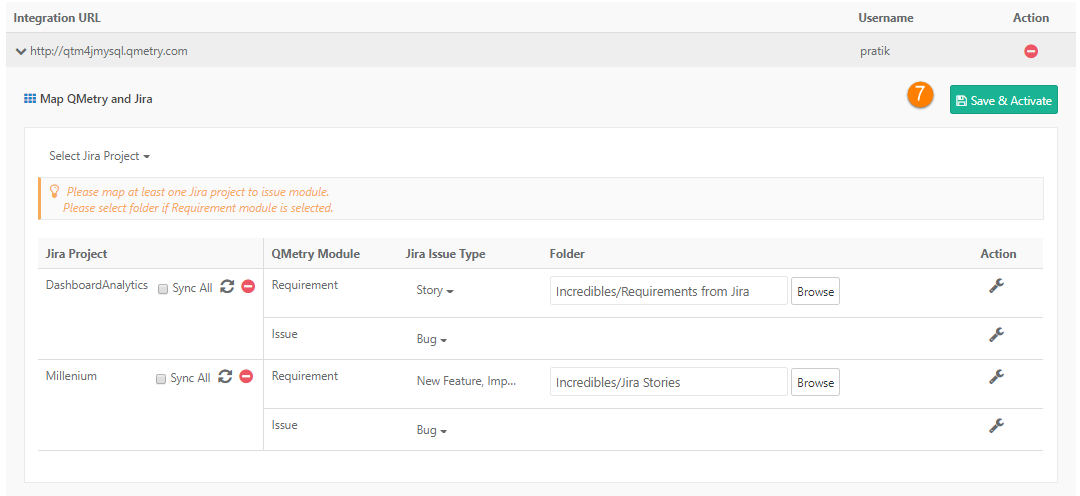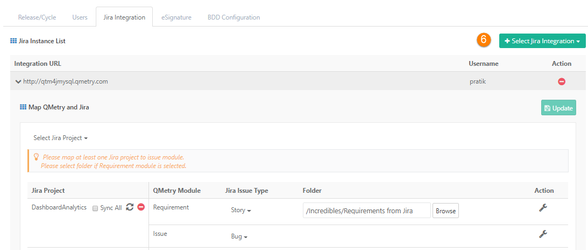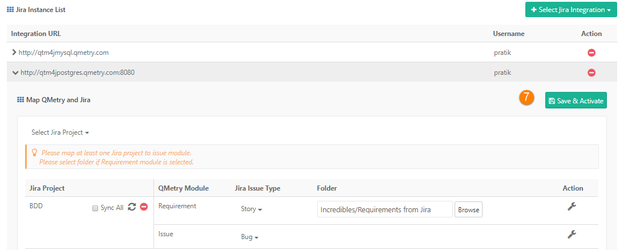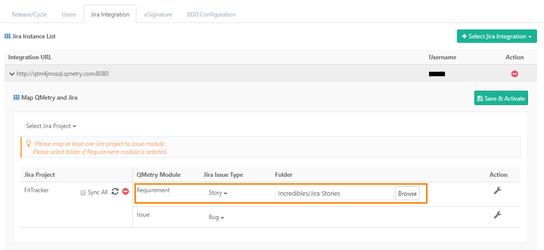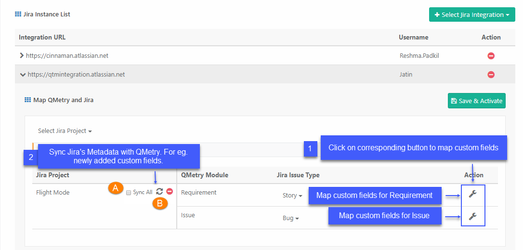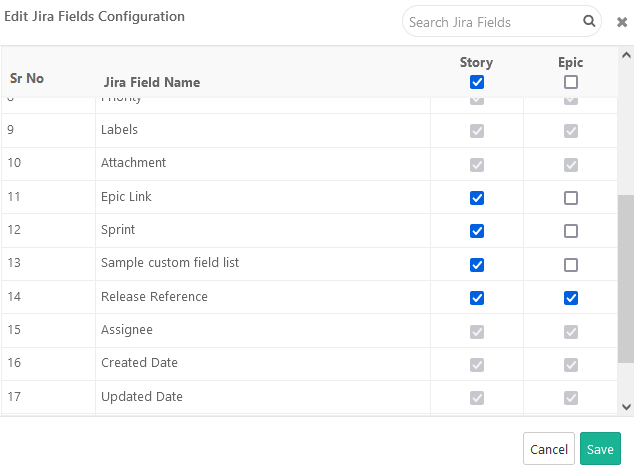Back to QMetry All Products Help Page
Map Jira projects, Issue type and Fields with QMetry Project
Map Jira Project with QMetry Project
Map Single Jira Project with QMetry Project
These steps have to be performed in QMetry by Login as QMetry Project Admin :
- Go to Projects > Project/Release/Cycle
- Open the Project > Jira Integration tab.
- Select the Jira URL with which this QMetry project mapping has to be done.
- Select the Jira project to configure with this QMetry Project.
- Once the Project is selected, select Issue Type <> QMetry Module associations. The issue type is a multi-select list. If the requirement is mapped, select the folder to import requirements.
- Click on Save and Activate.
Map multiple Jira projects from a single Jira instance with one QMetry project
QMetry allows multiple Jira projects to be configured with one QMetry project. Below are the steps for the same :
- Go to Projects > Project/Release/Cycle
- Open the Project > Jira Integration tab.
- Select the Jira URL with which this QMetry project configuration has to be done.
- Select the Jira project to configure with QMetry Project.
- Map Jira Issue Types to QMetry Modules.
Map Jira Issue types to QMetry modules
- Once the Project is selected, if you are managing your project requirements as Jira stories/epics/sub-task, you should select the Issue Types "Story", "Epic" or "Sub-task" to be associated with the Requirement module. Selection of Issue Type is a multi-select filter, which allows you to select multiple issue types and map with the requirement module. Selection of the folder where the imported issues will be created is mandatory. The first time sync will import all the issues to the selected folder. These issues can later on be moved to other folders in QMetry where any changes done to the issues will be synced. However, all the new stories/epics/sub-tasks that are not part of QMetry will be synced into the selected folder.
- To map issue types like bugs, tasks or sub-tasks to Issue module, users can select Issue Types associated to Issue module. This is a multi-select filter. The issue types that are mapped with Requirement module can not be mapped with the Issue module and vice-versa. The issues that would be imported and synced with QMetry, would be visible in Issue module with the external key indicating the Jira Issue Key.
- Click on Save and Activate/update once the configuration is done. ("Update" if Jira integration was already Saved and Activated for the QMetry project.)
- Go to Integrations and check the syncing of Requirement, Issue and Metadata is completed.
1. Jira sub-tasks can be imported into QMetry as Requirements or Issues. The Jira Sub-tasks details are displayed in the Sub- tasks Issues tab when Jira Sub-tasks are imported as a requirement or issue.
The sub-task issue details page shows the parent key of the sub-task to trace back to its parent entity. Read about Sub-task Traceability.
2. Epics can be imported in QMetry as Requirements or Issues. The Epic fields - Epic Link, Epic Status, Epic Color and Epic Name are supported and are available in the Jira details section of an Epic imported as a Requirement or Issue. Issues that are part of these Epics can be viewed in the "Issues in Epic" tab.
To view the issues of the Epic under the "Issues in Epic" tab, their issue types must also be integrated with the Jira project and synced in QMetry. These issues show the "Epic Link" (Epic Key) to trace back to its Epic. Read about Epic Traceability.
Map multiple Jira projects from multiple Jira instance with one QMetry project
QMetry allows multiple Jira instances to be configured with one QMetry project. Below are the steps for the same:
- Go to Projects > Project/Release/Cycle
- Open the Project > Jira Integration tab.
- Select the Jira URL with which this QMetry project configuration has to be done.
- Configure the projects > Save and Activate the Integration.
- Once the Project is selected, select Issue Type <> QMetry Module associations. The issue type is a multi-select list. If the requirement is mapped, select folder to import requirements.
- Select another Jira URL from the Jira Integration list.
7. Configure the projects > Save and Activate the integration.
8. Once the Project is selected, select Issue Type <> QMetry Module associations. The issue type is a multi-select list. If the requirement is mapped, select a folder to import requirements.
This way you can integrate multiple Jira instances with QMetry Project.
Map QMetry Folder to Import Requirements
Project Admin has to select a folder during Jira configuration to import requirements from Jira into QMetry. QMetry v8.5.1 onwards, it is mandatory to select a folder for requirement while Jira integration.
Users who were using QMetry v8.5 or below, requirements from Jira were imported in the Imported folder in QMetry by default. QMetry v8.5.1 onwards, Project Admin has to select a folder of their preference to import requirements in QMetry. Requirements already imported earlier will remain intact in their respective folders. New requirements will be imported in the folder selected during Jira configuration.
If the user changes already set folder, then a pop-up appears asking confirmation on changing the destination folder for new requirements that are being imported. The impact will be -
- Only new requirements will be moved to the synced folder.
- Requirements imported earlier will remain in their assigned folder only.
Copy / Move the Synced Folder
- On Copy/Move Folder, it will move folder to the new folder and update folder mapping on the Project screen as well.
Archive Folder
- Folders with external entities in it can not be archived. User can move the imported requirements to other folders and then can archive the folder.
- The folder that synced during Jira integration for import of requirements can not be archived.
- In bulk archive folder, the folders having external entity will be skipped. Sub-folders of this folder will also be skipped from bulk archive even they do not have external entities in them.
Change Mapping of Issue Type with Requirement module
Scenario 1. Issue Type mapped with Requirement is replaced with another Issue Type
Issues synced based on the earlier mapping will be converted into internal issues and they will no more be Jira issues.
New issues will be synced as requirements as per the changed Issue Type.
Scenario 2. In addition to existing Issue Type, another Issue Type is mapped with Requirement
Issues synced based on the earlier mapping will remain intact as Jira issues.
New issues will be synced as requirements as per the added Issue Type.
Configure Custom Jira fields for QMetry Module
QMetry displays default Jira issue fields in QMetry Modules. Project Admin can choose to display Jira custom fields as per project needs. Configuration of custom fields has to done separately for every configured Jira Project and Issue Type.
The following Jira field types are supported in QMetry:
- Number
- Date
- Date and Time
- Single line
- Multiline
- Multi Look Up Option
- Single Look Up Option
- User picker
- Multi-user picker
- Version picker
- Multi-version picker
Below are the steps :
Note : In case QMetry does not display a Jira field in the configuration screen - "Sync" project data to configure the field.
- Configure custom fields for Requirements and Issues.
- Sync Jira data to QMetry. For example, newly created custom fields, etc.
A. Sync All: It will sync all issues irrespective of their updated-date.
B. Sync: It will sync only those issue values which are recently updated in Jira based on their updated-date.
Jira’s custom fields can be configured (enabled/disabled) for each individual Jira issue types integrated with the QMetry project.
You can sync the mapped Jira custom fields in the QMetry Insight module for Visual Reports and Advanced Query Reports. Read more about Sync fields to Reports.
Note : At least one of the Jira Project should be integrated with Issue Module. Once the Jira is integrated with the QMetry project the internal issue module will be disappeared from the QMetry project.
You can view the status under Integration Scheduler Status tab under Integration > Integrations.
View Jira Integration Status
Users can view all the integrated Jira instances, their associated QMetry projects, and their current Status either Active or Inactive.
The Integration tab gives you a quick idea of the status of Jira and QMetry project integration.
Steps
- Expand Integration on the sidebar menu and select Jira Integrations. There are two tabs on the screen: Integration and Jira Scheduler Status.
- Open the Integration tab.
Back to QMetry All Products Help Page

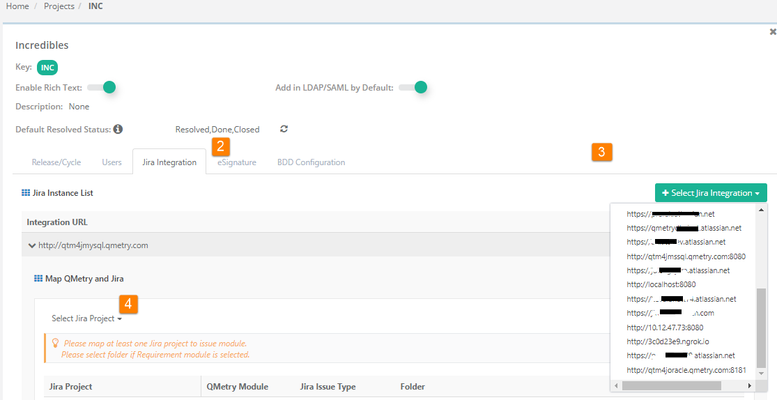
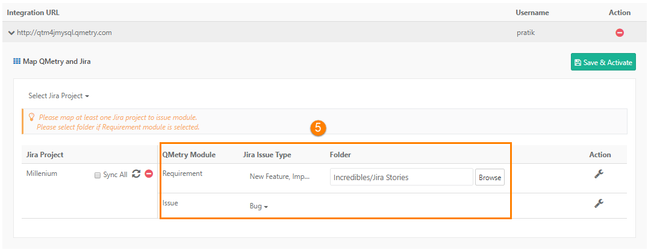

.png?version=1&modificationDate=1699075467978&cacheVersion=1&api=v2&width=842&height=400)
